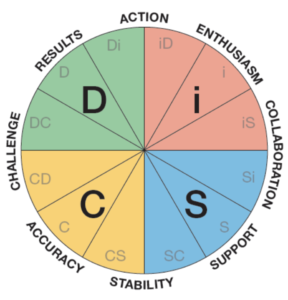WHAT IS THE DISC PERSONALITY ASSESSMENT?
DiSC® is a personal assessment tool used by more than one million people every year to help improve teamwork, communication, and productivity in the workplace.
Coaching clients can gain a lot of personal insight when they take the DiSC assessment and review it with their coach.
After completing the DiSC assessment a pie chart will be presented with your DiSC profile showing your four quadrants:
D = DOMINANCE
A person primarily in this DiSC quadrant places emphasis on accomplishing results and “seeing the big picture.” They are confident, sometimes blunt, outspoken, and demanding.
I = INFLUENCE
A person in this DiSC quadrant places emphasis on influencing or persuading others. They tend to be enthusiastic, optimistic, open, trusting, and energetic.
S = STEADINESS
A person in this DiSC quadrant places emphasis on cooperation, sincerity, loyalty, and dependability. They tend to have calm, deliberate dispositions, and don’t like to be rushed.
C = CONSCIENTIOUSNESS
A person in this DiSC quadrant places emphasis on quality and accuracy, expertise and competency. They enjoy their independence, demand the details, and often fear being wrong.

The pie chart will show your primary personality trait such as high D, and your secondary trait which may be high I or low I for example, with the other two traits further down in how you show up, communicate, and perform. You might be saying, hey, I am steady or I am dominate at times; while that’s great, what is being assessed is how you are the majority of the time based on data driven, engineered exams that are widely used by Fortune 500 companies and top entrepreneurs starting successful businesses. DiSC assessments provide a solid baseline to coach self-aware, high performing individuals to the next level of success.
HOW TO APPLY THE DISC PERSONALITY ASSESSMENT
Sitting across from my executive coach and the CEO who hired me, I’ll never forget my first DiSC assessment review.
CEO: So, tell me if I should keep Drew or fire him. Is he cut out for sales?
My Coach: Well, that’s a pretty direct way to put it which does not supise me since you are a very high D, which most CEOs tend to be.
CEO: Get to the point.
My Coach: Well, Drew is also a high D and high I, so you two will have an interesting time working together and should look for ways to improve your communication. Two dominant people can have challenges seeing eye to eye. Overall though, he has what it takes to make it in sales with the right coaching on how to bring out more I in the sales process to influence the decision making process, and to learn how to work each quadrant of the DiSC to communicate in ways other people feel valued.
CEO: You know your shit. Ok, I’ll keep him. How much is it going to cost if he works with you for a year and what is my return on investment?
Needless to say, there are many learning lessons in how my first DiSC assessment review went down. While leaders who are high D’s may be in positions of power paying for someone to go to executive coaching and sales training programs, high D’s need to remember that their direct nature can be seen as intimidating, threatening, and less than caring in today’s business environment that promotes vulnerability, trust, and holistic leadership development to reduce stress by creating psychologically safe workplaces.
Understanding your DiSC assessment and walking through it with an executive coach is extremely beneficial. Here’s why:
- Effective communication happens when you learn how others need to be communicated to, rather than pushing your communication style onto them
- DiSC assessments can help you evaluate whose on your team and where they may actually perform at a higher level given the way their mind works; imagine having your struggling employee take this test to find out they were in the wrong role all along, and then placing them in a new role within your company where they thrive. This is way better than letting good people go because the fit wasn’t right, when in fact, the fit was never assessed in the first place.
- Leadership teams can increase performance by knowing how to support key roles with the right amount of information or reduced information. Remember, D’s on your sales team need highly efficient expense report programs so they can focus on selling, whereas your accounting department needs highly detail oriented procedures to avoid audits and financial troubles. Trying to turn a D into a C or a C into a D does not work and infuriates employees deep down, whether they’ll admit this or not.
As you can see with just a few examples, there are many ways that leaders can use the DiSC to create high performing teams, healthy culture, and better business outcomes.
EXECUTIVE COACHING AND THE DISC ASSESSMENT
Executive coaching clients take the DiSC assessment and the Wheel of Life assessment. Both assessments provide insight into where the executive is in present time so we can talk about ways to improve leadership, communication, delegation, networking, soft skills, and ways to be more relatable to stakeholders.
Executive coaching looks at the DiSC as a key tool in the process, but not the overall makeup of who the executive is because humans are far too complex for any one assessment to paint us into a defined box.
Executive coaching aims to improve self-awareness, introspection, and key leadership skills necessary to developing healthy workplaces that are profitable and positive.
If you are interested in executive coaching, schedule a free consultation with me right now. We will talk about the coaching process and you can get started with your DiSC review within one business day. What are you waiting for?



